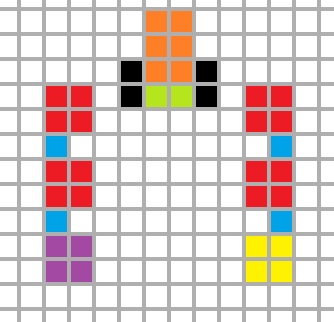
Hi!
First of all, as a gentle reminder, it’s winter flu/sickness season! Please be sure to take care of yourself, drink plenty of savory soups, and head to bed early. Trust me, you don’t want to catch what some of the team’s suffering through right now!
Secondly, I thought I’d pop up and talk a bit about how we’re, well, sorta not ships. You know we’ve talked about the strategies that are involved, or how we can turn around and aim and stuff.
But, I think today maybe we should look at the distinctive “thing” about us shipgirls (our equipment, gear, rigging, whatever the kids are calling it these days) that separates us from other heroic entities and characters in, well, these sorts of stories.
To get an idea of why we’re different, I’ve taken the time to sketch out an example of how a US battleship configures its space. This doesn’t represent any particular battleship, nor does it show you where the armor is or fine details like that.
Rather, it’s a very simple example of how compartments tend to work. If you like this, you should go check one out in more detail (and you can find them all over the internet!)

Okay, so a quick rundown of components (I told you it’s abstract! Haha), from “left” to “right” for those of us non-tech geeks.
Aviation: This is where the ship keeps its planes, the catapult to launch the places, and assorted storage materials like extra bombs and whatnots. Oh! I should note. When I drew this out, I categorized things by function in terms of their compartment. So, for instance, aviation here covers where the plane is located, the spare parts that’s a part of other components, and so on.
Personnel/Crew: This includes all kinds of living spaces, storage rooms for foods, ship’s stores, showers, messrooms, galleys (gallies?), bunks, sick bays, laundry and so on. You can see already it takes up a big portion of the ship’s space. Makes sense, too, right?
Storage/Tanks: This is where I decided to sketch out things like extra oil, drinking water, ballasts, lube oil, reserve tanks, things like that.
Outfit: Engineering! Repair stations, rudders, steering machinery, compressors and air conditioning, spare parts, construction stores, tool rooms, and workshops.
Gunnery/Fire Control: Gun directors, turrets, ammunition hoists, magazines and other ordnance stores, and lookout stations. These are pretty self-explanatory too.
Propulsion and Electric/Power: Again, pretty self-explanatory. Machinery room with the shaft and boilers and turbines and propellers are all a part of propulsion, and you’ll find the electrical stores and transformer rooms and the like in the other.
Ship Control & Offices: This is where you’ll find the pilot house, the various conning stations, the compass room, the plot room, and so on. I put the offices here as well because this is where a lot of the officers would be working, so you have stuff like the log room, the operations office, and the like.
Electronics: Where you find radar, telephones, and radios. I think next time I draw stuff I’ll probably put damage control in this section too. Just, however, remember that they’re there!
So, as you can see, everything pretty much makes sense, right? I mean, my historical counterpart is pretty much a big metal box with big guns that can float on water. How to get the metal box to its destination so the box’s guns can do the job, well, that’s why the navy pays all those engineers and ship designers and whatnots, right?
Now, let’s talk about shipgirls. Again, this isn’t anyone’s configuration in particular, but here’s an example of the sort of thing you’d see as a baseline for shipgirl operations.
Imagine I’m standing below you and you’re looking down from say, a few floors above…

Right off the bat you can see some pretty drastic differences, right?
- In a real battleship, there’s a lot of space dedicated to crew and engineering. In a shipgirl’s equipment, there’s a lot less space dedicated to the equivalent task because of the nature of fairy crews.
- Absent also are the ship’s navigation and various offices. In general, shipgirls themselves act as the “pilots” and move about on their own. Additionally, as each shipgirl is connected to her fairy crews, there’s little necessity for things like additional office space.
- The generally self-sufficient nature of shipgirls, the speed in which one can transport a shipgirl/have a shipgirl travel, coupled with STEC’s advanced logistics mean that shipgirls are naturally “designed” to have consistent access to resupply. In contrast, a real-life battleship sorties with weeks, often months of supply in mind, as the fastest battleships move at double-digit knots with travel timeframes on the order of days rather than hours or minutes.
This isn’t to say that say, specialized compartments or components don’t exist. However, we’ve used the term “modular” before to describe a shipgirl’s equipment, and the above is an example of a general scenario. We’ve got storage compartments for extended sorties, navigational components for challenging/extra-ordinary weather, ASW, AA, mine-sweeping, Chester-detecting, you name it!
We just don’t have to carry all of it all the time!
